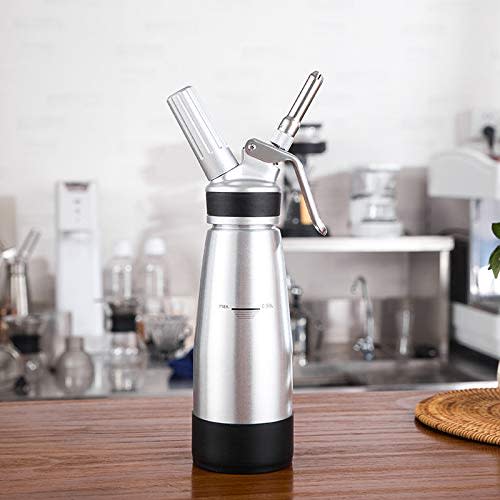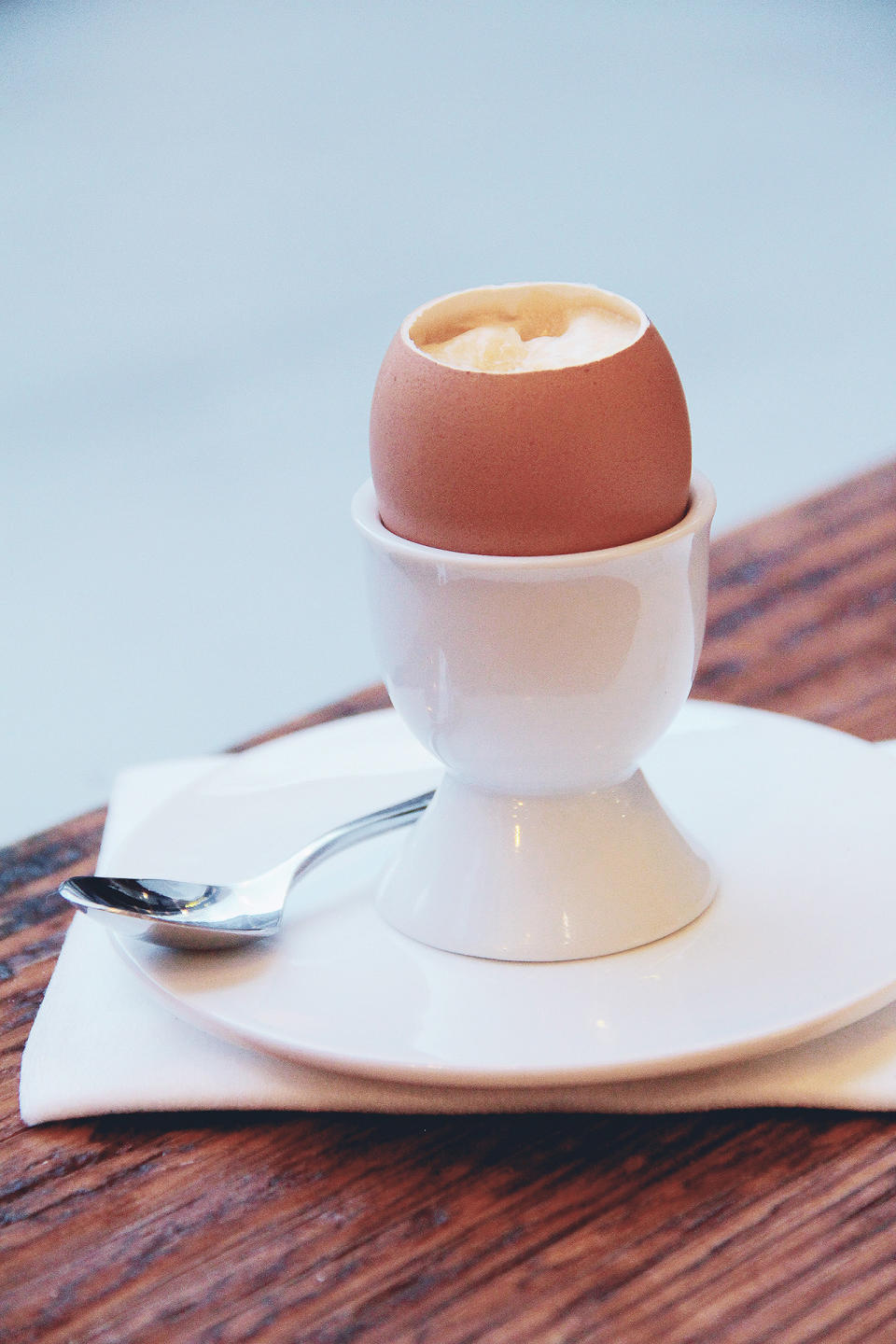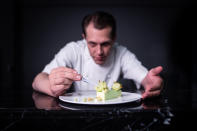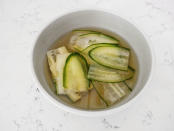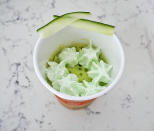Making a pickle-infused cake, for science
How much whipping is too much whipping?
Although I haven't had any formal training as a chef, I consider myself an above-average eater. So when I was presented with a whipping siphon -- the ruffian responsible for the foam craze that once plagued high-end restaurants and now appears in trendy cocktail bars -- I was confident my taste buds would make up for my lack of what you might call skills.
It all started earlier that week when I'd learned how to use the siphon from James Beard Award-winning pastry chef Michael Laiskonis. At Manhattan's Institute of Culinary Education, he'd demonstrated how to make his famous three-component pre-dessert from Le Bernardin called the Egg.
On first glance, the Egg looks like, well, a raw egg with the top of its shell removed. But dig in with a tiny spoon and you'll find milk chocolate pot de crème with a dollop of caramel sauce under caramel custard foam, topped with a drop of maple syrup and a few flakes of Maldon sea salt.
I met Laiskonis back in 2013 when he and a few other celebrity pastry chefs force-fed a group of gluttons an entire dinner of desserts at an event aptly called Killed By Dessert. I'd been following him around like a true addict ever since. The feeling must be mutual because a year-and-a-half ago, he wrote the foreword to my book, Bean-to-Bar Chocolate: America's Craft Chocolate Revolution.
Now he'd gamely agreed to show an unprofessional cook like me how to make the ultimate molecular gastronomy dessert. Tucked away with the rumbling machines in a lab at the end of a maze of professional kitchens and classrooms, chocolatey aromas wafted around us, and he constructed each component as nimbly as Pharrell dancing to "Sangria Wine."
He whisked a bowl under what I've come to think of as the ever-flowing chocolate fountain of youth (aka the tempering machine), catching the melted chocolate to make the pot de crème. My life will be complete when I have one of these gadgets, but in the meantime, I content myself with flinging raindrops of chocolate across my counters and shelves when I cook. Where Laiskonis is a graceful house cat, I'm a mutt trying to walk in boots.
As we finished the pot de crème and waited for it to cook, Laiskonis poured sponge-cake batter into the siphon, screwed on the lid and shook it decisively four or five times with one hand.
"You try," he said, ceremoniously handing me the canister. I held it with both hands and banged it up and down like a monkey trying to break open a coconut. Cream flew from the nozzle on to the table, the floor, Laiskonis' immaculately clean chef's coat.
"Yikes!" I proclaimed.
If I found myself on the kind of deserted island where I could only use one impractical kitchen tool for the rest of my life, the whipping siphon seemed like a good choice.
I proceeded to observe how years of practice had taught Laiskonis to smoothly remove the caramel-cream sauce from the heat the exact moment it started to wisp smoke, and I knew this would be easy for me to replicate at home.
A deep dive into the internet once my WiFi kicked in on the subway taught me everything else I needed to know about my new device: The siphon could be used to make pickles in a cinch, infuse spirits and even create the perfect foam for my next whiskey sour. If I found myself on the kind of deserted island where I could only use one impractical kitchen tool for the rest of my life, the whipping siphon seemed like a good choice.

A whipping siphon sounds like a complicated tool, but in reality it's pretty simple: It's a canister that aerates various liquids. A small cartridge of gas called a charger pressurizes the interior of the canister, forcing some of the gas into the liquid inside. That changes the composition of the liquid, transforming it into a foam or even a sparkling beverage.
As a food writer, I'd pushed foam around my plate plenty of times, rolling my eyes as the chef described "the evanescence of kale." But I'd never considered using a siphon myself because I spend the better part of my life dropping full glasses of water, bumping into furniture and generally having trouble with three-dimensional objects (it's called "pulling a Megan" in my house).
Now was my time. And my first and second kitchen attempts proved that I was, in fact, a molecular-gastronomy prodigy.
I started out creating a hearty dinner of pickles. I sliced up half a cucumber and brought my vinegar-and-herb brine to a boil, as I would to make the traditional variety. But rather than plopping a dozen or so slivers in a jar and waiting, I plopped them straight into my siphon, turned it on its side for a few minutes, then let all the gas out of the tank. The quick expansion when you add gas to the siphon breaks up the cucumber's tissue, and when you release the gas, the brine rushes into those broken spaces. I opened it up and... pickles! Fresh and crunchy.
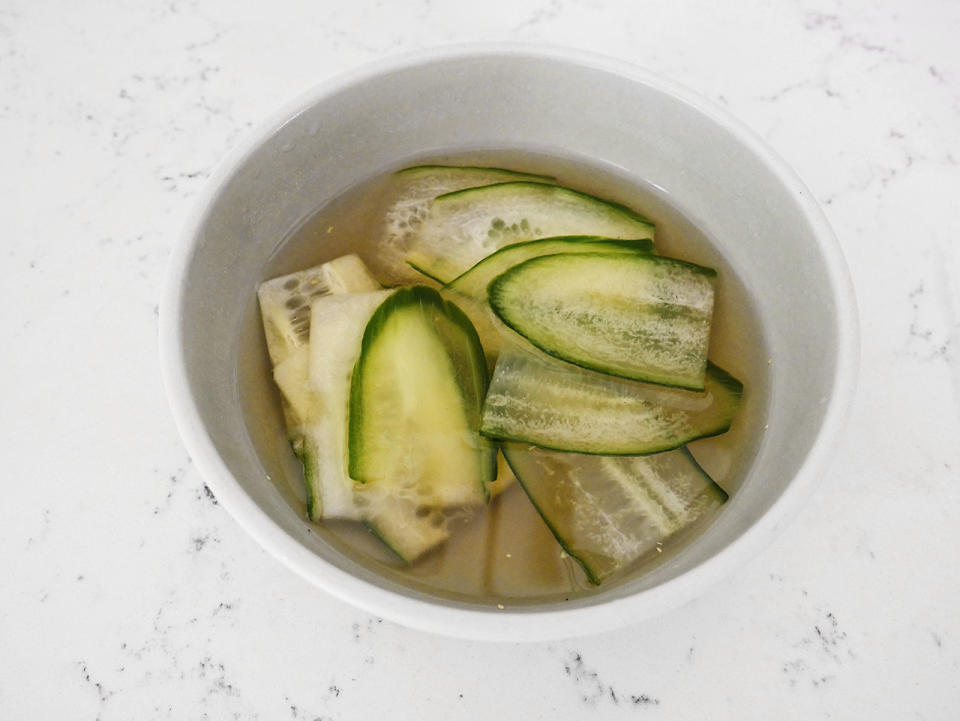
Next, like famed chef Ferrán Adria before me, I poured a carefully constructed peanut butter batter into the siphon, shook it like Tom Cruise in Cocktail, then microwaved the mixture in paper cups for 30 seconds. The resulting nut-buttery cake was the lightest sponge I'd ever tasted. I ate it in one bite as I gulped a whiskey sour with amaretto foam, made by yours truly, now a certified molecular-gastronomy mixologist.
This bolstered my confidence to tackle the Egg recipe.
Laiskonis served this dessert regularly when he was the executive pastry chef at three-Michelin-star restaurant Le Bernardin in the aughts, though only to VIPs. "Everyone's a VIP, but then you have the next level of VIP," he explained to me -- unnecessarily, I thought, as I was obviously in that tier. "In lieu of getting a dessert on the menu, Tim Zagat of the Zagat Guide would ask for two to three eggs on a plate."
Despite never being on the official menu at Le Bernardin, the Egg has become so famous that it has copycats all over the world, one of which, in the Philippines, pays mad respect by simply calling it the Laiskonis Egg. These days Laiskonis only brings it out for special occasions, like Valentine's Day at his new dessert café in New York City, Recolté.
The Egg by Michael Laiskonis

Step 1: shells
Ingredients:
12 large brown eggs
1. Carefully remove tops from eggs, reserving contents for another use. Keep the bottom half of the fiberboard egg carton for baking. Do not use Styrofoam or plastic cartons as they will be going into the oven!
2. Rinse empty shells in very hot water and carefully remove the remaining inner membrane. Allow shells to dry.
Step 2: caramel-custard foam
Ingredients:
75g granulated sugar (1)
25g water
115g heavy cream
115g whole milk
2 large egg yolks
15g granulated sugar (2)
1 sheet gelatin, bloomed
1. In a small saucepan, add first measurement of sugar (1) and water and cook to a medium caramel. Meanwhile, gently warm the cream and milk. When the caramel reaches the desired color, add the warmed cream in small additions, followed by the milk. Bring the mixture to a boil over medium heat, making sure any hardened caramelized sugar is dissolved.
2. Meanwhile, combine and whisk the egg yolks and remaining sugar (2). Temper the hot cream into the egg yolks. Return to medium-low heat and cook, constantly stirring, until mixture is slightly thickened and reaches 85°C/185°F. Remove from heat, whisk in gelatin and strain through a fine-mesh sieve. Chill in an ice-water bath. Refrigerate until well chilled.
3. Transfer the cooled custard to a whipped-cream siphon assembled according to manufacturer's instructions. Reserve in the refrigerator until assembly.
Step 3: milk chocolate pot de crème
Ingredients:
90g heavy cream
90g whole milk
2 large egg yolks
30g granulated sugar
30g high-quality milk chocolate, finely chopped
1. Preheat a convection oven to 300˚F. Combine cream and milk in a small saucepan and bring to a boil. Meanwhile, combine and whisk the egg yolks and sugar. Remove scalded cream mixture from heat and temper the mixture into the egg yolks; whisk in milk chocolate, until thoroughly incorporated. Strain through a fine-mesh sieve.
2. Place egg shells right side up in their carton and place in a shallow pan. Carefully divide milk-chocolate custard evenly among eggshells, just under one ounce, or about halfway.
3. Fill hotel pan with hot water, just until water reaches the bottom of the eggs and begins to saturate the egg carton. Cover with foil and bake for about 20 to 30 minutes, or until custard is set. Allow to cool to room temperature.
Step 4: caramel sauce
Ingredients:
100g granulated sugar
50g water
A few drops of lemon juice
85g heavy cream
15g unsalted butter
1. Combine sugar, water and lemon in a small saucepan. Cook to a medium amber color. Meanwhile, gently heat the cream until warm. Remove caramelized sugar from heat and gradually add the cream. Return to low heat to completely dissolve sugar.
2. Remove from heat and whisk the butter into the caramel. Keep warm.
Step 5: assembly
Ingredients:
Maple syrup
Maldon sea salt
1. Transfer cooled eggshells to 12 porcelain egg cups.
2. Pour a very thin layer of caramel sauce into each eggshell, over the chocolate custard. Fill the remainder of the shell with the caramel foam. Drizzle a few drops of maple syrup on top of the foam and sprinkle each eggshell with a few grains of Maldon sea salt. Serve immediately.
When Laiskonis made it for me, he skillfully plucked off the crown of a raw egg using a device called an egg topper, which looked like a hifalutin finger trap. He'd lent me the topper, so at home, I opened the egg flawlessly and poured its contents into a waiting bowl. Sure, I cracked a few eggs removing the inner membrane, the resulting shells looking like some snaggly toothed monster had nibbled off their tops. But I told myself it was an improvement over the standardized, smooth-lipped eggs of industrial domination: Mine were artisanal.
Similarly, I aced making the pot de crème, mildly scrambling the eggs with hot cream and milk and letting it set in the oven until the custard was alarmingly springy on top yet icy raw in the middle.
Amid this amateur baking hour, the easiest part was using the whipping siphon. After making the caramel-custard base, I poured it into an iSi whip canister the way Laiskonis showed me. The technique is basically the same whether you're making a cake or a foam.
The siphon looks like a thermos with the spout of a whipped-cream canister. You pour your batter into the metal canister, close it up, then insert a bullet-shaped "charger" full of nitrous oxide into a little red handle. As you screw the handle into the canister, you hear a whizz as the gas releases, pressurizing the contents. From there, you shake it not like a Polaroid picture, turn it upside down, and gently press the lever to release a stream of foam. My caramel-custard foam turned out thick and gorgeous, just like Laiskonis'.
How a whipping siphon works
Siphons come in all sorts of sizes, starting at half pints, and each charger holds eight grams of gas. (You'll need one or two to fully pressurize the siphon.)
Beware what type of charger you use, though, as there are two versions that are often mistaken for each other. Nitrous oxide should be used to marinate, infuse and create foams. Carbon dioxide should only be used to create carbonation. "If you've ever tasted a mousse aerated with CO2, it is not delicious," quipped Laiskonis .
With nitrous oxide, you can use any liquid that will bubble, but the higher it is in fat, the easier the gas will dissolve into it. Often eggs, gelatin or starch are used to thicken liquids before they're poured into the siphon.
Don't think that a siphon with CO2 is just a glorified SodaStream, though. There are plenty of ingenious uses. Imagine, Laiskonis said, filling the siphon with raspberry spheres, then inserting a carbon-dioxide charger. The result? Spheres of raspberry soda.
But instead of celebrating these debatable successes, I realized I was being derivative, merely using someone else's recipes. Luckily, as often happens when I've created the Machu Picchu of dirty dishes, I had a brilliant idea. Why not combine all the siphon's uses into one delicious meal?

Nitrous and carbon dioxide chargers have been used since the early 20th century, mostly for making whipped cream and seltzer. (Also for teenagers huffing Whip-Its in parking lots after dark.)
The molecular-gastronomy movement changed that forever. (Not the teenagers -- they're still doing that, unfortunately.) In the late 1990s, Spanish chef Ferrán Adria at El Bullí, which for a time was known as the best restaurant in the world, used a siphon to invent espuma -- what we know as culinary foam.
Suddenly chefs were making decadent, foamy sauces with all sorts of intense flavors. Kiwi-caramel foam, hot tobacco froth: For better or worse, high-end restaurants around the globe were obsessed. "It's easy to attempt -- and easy to screw up," Laiskonis explained.
"But all kinds of great things are foams," he continued. "Meringue, whipped cream -- even bread is a type of foam."
Adria and his brother Albert would probably agree, but their goal at El Bullí was to push flavor and texture forward in unique ways. In 2007, they discovered a way to manipulate batter to create a light, flavor-dense cake that's perfect next to spheres of ice cream, chocolate soil and foam as part of a fancy dessert. By aerating the batter in a siphon and then microwaving it, the two created something pastry chefs had been lusting after for years.
"It's impossible to use conventional methods to get such a light, flavored cake," Laiskonis explained. Even angel food cake would be weighed down by additions like chocolate, peanut butter or black sesame paste, the original flavor at El Bullí.
Recipe: Peanut sponge cake by Michael Laiskonis
Makes 8 small cakes
Ingredients:
100g peanut butter
10 whole eggs, room temperature
20g rice flour
50g sugar
2g salt
1. Thoroughly combine all ingredients and blend with immersion blender; pass through a fine-mesh sieve.
2. Transfer the mixture to a one-pint foam siphon and load two gas chargers, per manufacturer's instructions. Shake siphon vigorously.
3. Holding the siphon upside down, dispense the mixture into medium paper cups.
4. Place in microwave and cook on high power for 35 to 40 seconds.
Of course, the microwave component has intrigued more than just chefs, and since 2009, the internet has shown us how to make mug cakes in the microwave. It's essentially the same technique, minus the siphon -- throw all the ingredients into a mug and then blast it on high. It creates the perfect single-size dessert in seconds, which is perhaps why you'll find recipes as varied as award-winning pastry chef Christina Tosi's pretzel mug cake to Bodybuilding.com's double chocolate protein mug cake to Duncan Hines pre-made mug cake mixes.
I cannot -- or will not -- tell you how many times midnight has found me mixing miniscule quantities of flour, sugar, almond milk and salt into an oversize Ruth Bader Ginsberg coffee mug, then transferring the jumble into the microwave for 30 seconds. The results aren't nearly as light as Adria's sponge, but they'll satisfy when you have an intense craving for sweets. Mug cake: from haute cuisine to Hot Pocket status, in less than a decade.
Chefs still use the siphon often though they're not as loud about it. "The best stuff sticks; it's just no longer about putting the technique at the forefront," explained Laiskonis.
In the past decade, it's also made the jump to the bar. Food-scientist Dave Arnold started playing around with the siphon to make cocktails in the mid-2000s at the International Culinary Center in NYC. Then he opened a bar with Momofuku's David Chang called Booker & Dax that highlighted the many ways technology can manipulate alcohol. That paved the way for countless mixology programs across the world to up their game. Locales like Aviary and Existing Conditions in NYC, for example, create mad-scientist foams, infused alcohols and other treats using the siphon and their bartenders' liquid intelligence. The siphon cocktails being created now are almost exciting enough to resurrect foam from the dead.


After hours of recipe testing (and failing), I gathered the ingredients for my official masterpiece: eggs, flour, sugar, cream, whiskey and the pièce de résistance, pickles.
I improvised on Laiskonis' recipe for a sponge cake to whip up a reptilian-colored pickle batter. I chucked it into the microwave and admired the smell of hot pickles wafting delicately through the house.
While the cake cooled, I whipped more hot pickles into cream, which aerated gorgeously, though I have to say it was more like the sturdy whipped cream from T.G.I. Friday's than the flimsy foam from El Bullí. I plated it like a pro, complete with slices of pickle garnish.
Finally, I tasted the cake: light and toothsome, with a garlicky hint to round out the dairy and a bit of cucumber skin to chew on long after swallowing. Once the sun rose, I'd start plotting to talk to a few investors about opening my own restaurant.


